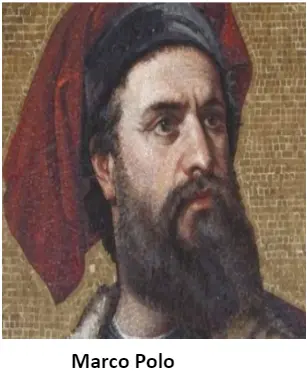Marco Polo, a Venetian merchant, embarked on a remarkable journey along the Silk Road to Asia in the 13th century. His adventures, chronicled in ‘The Travels of Marco Polo,’ led him to India’s Coromandel Coast in 1292, where he explored the Tamil Pandya kingdom and encountered diverse customs and landscapes
Overview of Marco Polo’s Fascinating Journey and Observations
1. Marco Polo’s Journey to Asia
-
- Marco Polo: He was a merchant from Venice.
- He served as the emissary of the Mongol emperor Kublai Khan for 17 years, exploring various parts of Asia.
- Journey Along the Silk Road: He traveled to Asia along the Silk Road in the 13th century.

- Recording the Adventures: The story of his travels is recorded in ‘II Milione (The Million) which is also called ‘The Travels of Marco Polo’.
- Arrival in India: In 1292 AD, Marco Polo landed on India’s Coromandel Coast on his way home from China.
- Exploring the Tamil Pandya Kingdom: He arrived in the Tamil Pandya kingdom, which is close to Tanjore.
- Rudramma Devi’s Reign: During the Rudramma Devi of the Kakatiya Dynasty’s reign, he traveled to southern India.
- Kerala and Tamil Nadu: were the two stops for Polo.
2. Observations on Indian Customs
-
- Agricultural Practices: The only grain grown there was rice.
- Safety and Travel Customs: It was safe to travel at night with the valuables.
- Drinks and alcohol consumption predominated despite the lack of beef consumption.
- Natural Environment and Wildlife: According to his description, the wildlife and flora were superior to those found in Italy, both in terms of size and beauty.
- There were plenty of lions, leopards, lynxes, peacocks, and scarlet and blue parrots.
- Plantations and Agricultural Products: He also mentioned plantations with pepper and indigo, incense, and a beverage made from date wine.
- Hygiene Practices: The left hand was reserved for dirty chores when people used to sit on the ground and only use their right hands to eat and drink.
- Chewing Habits: Indians chewed a leaf called tambur and freely spat it out.
- Clothing and Adornments: Men and women were just dressed in loincloths due to the extreme heat.
- Economic Wealth: Marco Polo considered the Pandya kingdom in South India as the richest and most splendid province in the world, known for producing pearls and gems.
- Religious Practices: Indians consulted astrologers, had Brahmins as enchanters, and practiced sati in certain communities.
- Cultural Beliefs: Indians venerated cows, avoided eating beef except for certain low-status groups, and looked down upon sailors due to cultural taboos.
- Beauty Standards: Dark skin was preferred in South India, and lighter-skinned people were made darker with oils.
- Spicy Tales and Observations
-
- Kings and their Lives: Marco Polo told tales of kings with hundreds of wives and concubines, and of wars averted by emotional blackmail.
- Naked Holy Men: He met ascetic holy men who believed in non-violence and went naked to renounce worldly desires.
- Grounded Customs: In Thanjavur, the king explained the honor of sitting on the earth, symbolizing the connection to the land.
- Religious Sites: visited the tomb of St. Thomas the Apostle near Chennai, a pilgrimage site for Christians and Muslims.
- Economic Activities: South India was known for importing horses, producing fine textiles, making date wine in Kerala, and having leather workshops and plantations.
- Appreciation of Nature: Marco Polo admired the biodiversity of South India, including its birds and animals.
Conclusion
Marco Polo’s travels offer a vivid glimpse into Indian culture and natural beauty. From the agricultural practices centred around rice cultivation to the vibrant wildlife and flora, his observations shed light on the customs, beliefs, and economic activities of southern India during his time.
![]() May 16, 2024
May 16, 2024
![]() 11306
11306
![]() 0
0
